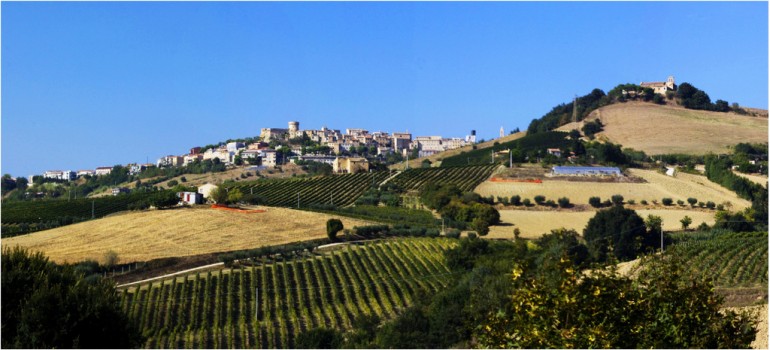
Acquaviva is situated on two adjacent hills (the highest is 360 m ), the whole territory extends in a hilly area between the rivers Tronto and Tesino at about 7 km from the sea and San Benedetto del Tronto. The whole area has great archaeological interest: The first human remains date back to prehistoric times, more remains dating Paleolithic and Neolithic periods were found in the 70’s and the evidence of Piceno settlements (dating 6th century B.C.) is confirmed by many remains found alla over the territory. The town’s origins are probably related to the changing conditions of security policies due to the constant incursions of the Lombards and later the Saracens; this induced local population to settle in the hills a little further away from the coast. Between the 9th and 10th century Acquaviva became a settlement defended by walls and reinforced by a castle ( Rocca). Towards the end of 1220 the construction of the eastern part of the medieval village aimed to accommodate refugees from several neighboring castles. Later it was often fought over for its strategic location and became possession of the Abbey of Farfa and domain of the Dukes of Acquaviva and Atri, who prospered there and consolidated the village as an invincible fortress. The Acquaviva family had an important role in the struggle between Empire and Papacy. In 1341 the estate was sold to the town of Fermo for strategic purposes to control the coast from San Benedetto del Tronto to the possessions of the enemy Ascoli. Owing to its position Acquaviva was permanently in a state of alert, if not open war, defending its territory or being assaulted by bandits, it joined the Province of Fermo and was part of the Papal state until the “Risorgimento” and in 1860 it became part of the kingdom of Italy and the Province of Ascoli Piceno. The town is dominated by the Rocca, a masterpiece of military architecture of the 10th century, where one can visit the Pajarole Museum, typical artisan products made with wheat straw and wicker. In the center there are the Church of San Rocco, a fine example of medieval military architecture, and also the oldest church built within the walls of Acquaviva, the Church of St. Nicholas, dating 13th century and finished in 16th century, the Church of San Lorenzo, founded in 1613 by the Augustinians, the small Church of St. Joseph, with its white brick façade, the ancient circular window and the bell tower , Palazzo Chiappini, the Town Hall, and its magnificent Hall of the “Palio”. Outside the old town there are the Church and Convent of St. Francis, one of the first of the Franciscan order, both dating the 12th century and the Church Our Lady of Mercy, Baroque style with a polygonal perimeter, the Church of Santa Maria in Accubitu, of medieval origin and the Church of Santa Maria delle Palme, an extra- small medieval chapel with bell tower.